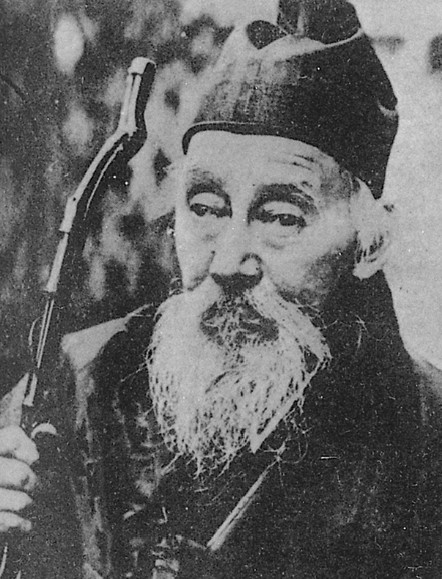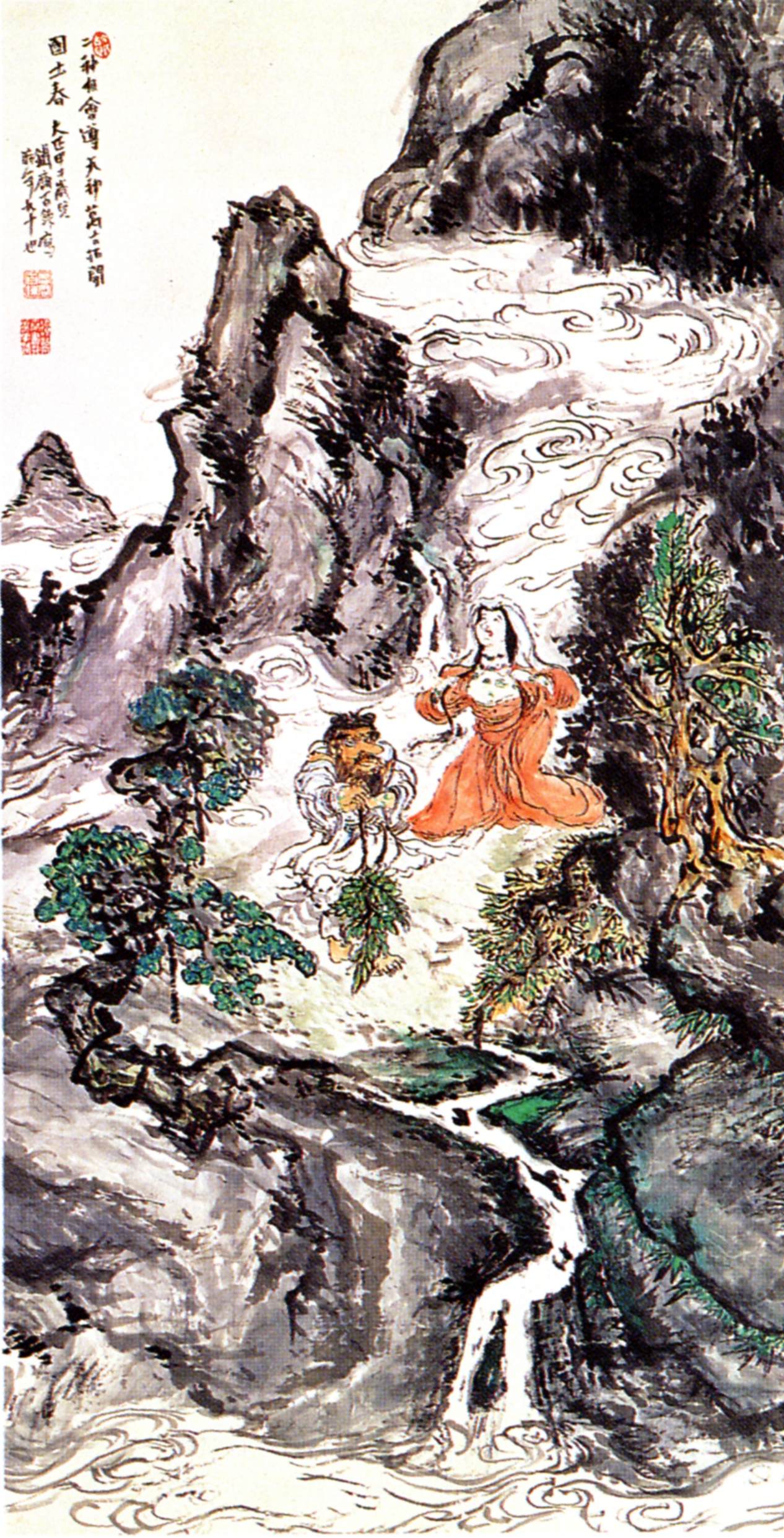- Tomioka Tessai
Infobox Artist
name = Tomioka Tessai

imagesize = 180px
caption = Tomioka Tessai
birthname = Tomioka Yusuke, Tomioka Hyakuren
birthdate = birth date|1837|01|27
location =Kyoto ,Japan
deathdate = death date and age|1924|12|31|1837|01|27
deathplace =
nationality = Japanese
field = Painter, Calligrapher
training =
movement =Bunjinga ,Nihonga
works =
patrons =
awards = nihongo|Tomioka Tessai|富岡鉄斎|Tomioka Tessai|extra=27 January 1837 –31 December 1924 was the pseudonym for a painter and calligrapher inMeiji period Japan. He is regarded as the last major artist in the "Bunjinga " tradition and one of the first major artists of the "Nihonga " style. His real name was Tomioka Yusuke, which he later changed to Tomioka Hyakuren.Early life
Tessai was born in 1837 in
Kyoto , as the second son of Tomioka Korenobu, who sold sacerdotal robes. Because his hearing was not good his parents decided he should be a scholar, rather than a merchant. He was educated as a scholar in classicalChinese philosophy and literature and the ancient Japanese classics under noted "kokugaku " scholarOkuni Tadamasa .Tessai's father died in 1843, when he was only seven. The family fortunes declined, and young Tessai became a page at a
Shinto shrine. Twelve years later, he came to be lodged with the now-famousBuddhist poet and nunOtagaki Rengetsu , who would become his greatest scholarly mentor and supporter. He developed his own style over the next decade or so, studying under a number of accomplished painters.Early career
In 1861, Tessai opened a private school in Rengetsu's house to teach painting; he went on to become a teacher at the newly inaugurated
Ritsumeikan University in 1868. He also did some work for the newMeiji government , contributing maps and topographical charts he created. Throughout the Meiji period, Tessai traveled extensively, visiting famous and scenic places that would later become subjects of his paintings. He was able to see many different sides of the country all the way from Nagasaki toHokkaidō . He also served as a Shinto priest at a number of different shrines, but ultimately resigned from his final post when his brother died, so that he could look after his mother.Artistic style
After Tessai settled back in Kyoto in 1882, he championed the old styles of Japanese traditional painting against the new influences of western art "(yōga)," then becoming more and more popular, and was thus a participant in the early "
nihonga " movement.Tessai's early works followed the "
bunjinga " styles of the early 19th century, although he also worked in almost all of the styles associated with Kyoto: "Rimpa ,Yamato-e ,Otsu-e ," etc. However, his mature style concentrated on "Nanga ," or Chinese style paintings based on the lateMing dynasty artists fromSuzhou andJiangsu Province s, which had been introduced to Japan bySakaki Hyakusen . Tessai tended towards use of rich colors to portray scenes of people in landscapes, with a composition intended to evoke or illustrate a historical or literary episode. He also sometimes made use of religious imagery, combining depictions of Buddhistbodhisattva with Daoist or Confucian figures to symbolize the unity of Asian religious traditions. Tessai's final works either use very brilliant colors, or else were monochrome ink with dense, rough brushwork and occasional slight jarring touches of bright pigments.Later career
Infobox Painting|

title=Two Divinities Dancing (二神会舞図)
artist=Tomioka Tessai
year=1924
type=Nihonga watercolor onsilk
height=169
width= 86
height_inch=
width_inch =
city=Tokyo
museum=Tokyo National Museum In the 1890s, he was appointed a judge of the Young Men's Society of Painting, and became a professor at the Kyoto Fine Arts School soon afterwards. He also took part in the founding of several other art associations, including the Nanga Association of Japan. His mother died in 1895, but Tessai continued to have close relations with his family and gained a granddaughter several years later.In 1907, he was appointed official painter to
Emperor Meiji , who so liked his works that his commission was extended to cover theImperial Household Agency as acourt painter in 1917. He was also appointed a member of the Imperial Fine Arts Academy ("Teikoku Bijutsu-in") in 1919.Throughout his life, Tessai served as a
Shinto priest and a scholar. He was an extremely prolific painter, and it is estimated that he painted approximately 20,000 paintings in the course of his career. On one occasion he completed 70 paintings in a single day. According to the nun Rengetsu, his greatest mentor, Tessai's best works were created in the last years of his life, from age 80 to his death in 1924 at age 88.The largest collection of Tessai's works is at the Tessai Memorial Museum, a private art museum within the grounds of the Kiyoshikojin Seicho-ji, a Buddhist temple in
Takarazuka, Hyogo .Important works
*「阿倍仲麻呂明州望月図」「円通大師呉門隠栖図 (1914, Important Cultural Property) Hakutaka Museum
*「二神会舞図」Tokyo National Museum
*「旧蝦夷風俗図」(1896) Tokyo National Museum
*「不尽山頂全図」
*「蓬莱仙境図」
*「弘法大師像図」
*「蘇東坡図」
*「武陵桃源図」 (1923)
*「瀛洲遷境図」 (1923)
*「阿倍仲麻呂在唐詠和歌図」Adachi Art MuseumExternal links
* [http://www.adachi-museum.or.jp/e/c_tessai.html Adachi Museum on Tessai]
* [http://www.kiyoshikojin.or.jp/tessai/ Tessai Memorial Museum (Japanese site)]
* [http://www.art-antiques.ch/objects/1200-1299/1277.html Tomioka Tessai (1836-1924) 富岡鐵斎 Hanging Scroll (Kakemono 掛物)]References
* Briessen, Fritz van. "The Way of the Brush: Painting Techniques of China and Japan". Tuttle (1999). ISBN 0804831947
* Conant, Ellen P., Rimer, J. Thomas, Owyoung, Stephen. "Nihonga: Transcending the Past: Japanese-Style Painting, 1868-1968". Weatherhill (1996). ISBN 0834803631
* Musanokoji, Saneatsu. "Concerning Tessai". (Journal title and year unknown)
* Odakane, Taro. "Tessai, master of the literati style". Kodansha International (1965). ASIN: B0007IT90M
Wikimedia Foundation. 2010.
